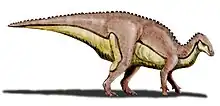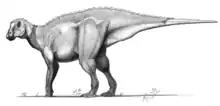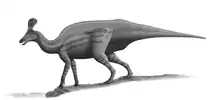| Leaellynasaura Temporal range: Early Albian | |
|---|---|
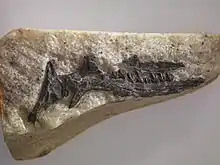 | |
| Holotype dentary | |
| Scientific classification | |
| Domain: | Eukaryota |
| Kingdom: | Animalia |
| Phylum: | Chordata |
| Clade: | Dinosauria |
| Clade: | †Ornithischia |
| Genus: | †Leaellynasaura Rich & Rich, 1989 |
| Species: | †L. amicagraphica |
| Binomial name | |
| †Leaellynasaura amicagraphica Rich & Rich, 1989 | |
Leaellynasaura (meaning "Leaellyn's lizard") is a genus of small herbivorous ornithischian dinosaurs from the Albian stage of the Early Cretaceous (dated to between 118 and 110 million years ago[1]), first discovered in Dinosaur Cove, Australia. The only known species is Leaellynasaura amicagraphica. It was described in 1989, and named after Leaellyn Rich, the daughter of the Australian palaeontologist couple Tom Rich and Patricia Vickers-Rich who discovered it. The specific name, amicagraphica, translates to "friend writing" and honours both the Friends of the Museum of Victoria and the National Geographic Society for their support of Australian paleontology.[2]
Description
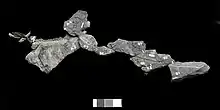
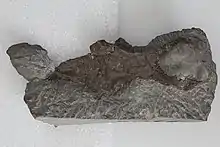
Leaellynasaura is a relatively small dinosaur, about 90 centimeters (3 feet) in length.[1] It is known from several specimens including two nearly complete skeletons and two fragmentary skulls. Herne (2009) argued that, unlike more advanced ornithischians, Leaellynasaura lacked ossified tendons in its tail. He also argued that the tail is noteworthy as among the longest relative to its body size of any ornithischian: the tail was three times as long as the rest of the body combined; it also has more tail vertebrae than any other ornithischians except for some hadrosaurs.[3] However, in a subsequent revision of fossil material attributed to Leaellynasaura Herne (2013) could not confidently assign the postcranial skeletons with long tails (or indeed any fossils other than the holotype incomplete cranium MV P185991, right maxilla MV P186352 and left maxillary tooth MV P186412, all from late Aptian-early Albian Eumeralla Formation) to Leaellynasaura amicagraphica.[4]
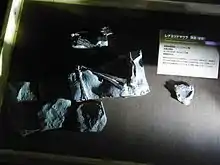
Classification

Leaellynasaura has been variously described as a hypsilophodontid, a primitive iguanodontian or a primitive ornithischian (Genasauria). Recent studies have not found a consensus; some analyses describe it as a non-iguanodontian ornithopod,[5] whereas others describe it as a basal neornithischian.[6] A 2019 study recovered it as a member of Elasmaria.[7]
Position according to Herne et al., 2019:[7]
| Ornithischia |
| ||||||||||||||||||||||||||||||||||||||||||||||||||||||||||||||||||||||||||||||||||||||||||||||||||||||||||||||||||
Biology and ecology
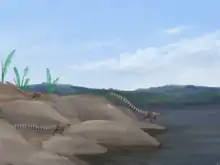
Leaellynasaura was an Australian polar dinosaur. At this period in time, Victoria would have been within the Antarctic Circle. Although this latitude is very cold today, it was significantly warmer during the mid-Cretaceous. Because of the Earth's tilt, Leaellynasaura and its contemporaries would still have been living under conditions with extended periods of both daylight and night. Depending on latitude, it is possible that the sun might not have risen for several weeks or months in the winter, which means that Leaellynasaura would have had to live in the dark for perhaps months at a time. A skull fragment interpreted as being from Leaellynasaura has been reported as showing enlarged eyes and the suggestion of proportionally large optic lobes, implying an adaptation to low-light conditions.[8] However, the relatively large orbits of this specimen were more recently interpreted as representing characteristically large eyes of a juvenile individual,[5] rather than any low-light adaptation.
References
- 1 2 Holtz, Thomas R. Jr. (2012) Dinosaurs: The Most Complete, Up-to-Date Encyclopedia for Dinosaur Lovers of All Ages, Winter 2011 Appendix.
- ↑ Rich, T. and Rich, P. (1989). “Polar dinosaurs and biotas of the Early Cretaceous of southeastern Australia.” National Geographic Research, 5(1): 15–53.
- ↑ Herne, M. (2009). "Postcranial osteology of Leaellynasaura amicagraphica (Dinosauria; Ornithischia) from the Early Cretaceous of southeastern Australia." Journal of Vertebrate Paleontology, 29(3): 33A."Archived copy" (PDF). Archived from the original (PDF) on 2010-07-15. Retrieved 2010-07-05.
{{cite web}}: CS1 maint: archived copy as title (link) - ↑ Herne, M. (2013). "Anatomy, systematics and phylogenetic relationships of the Early Cretaceous ornithopod dinosaurs of the Australian-Antarctic rift system" PhD Thesis. The University of Queensland
- 1 2 Federico L. Agnolin, Martın D. Ezcurra, Diego F. Pais and Steven W. Salisbury (2010). "A reappraisal of the Cretaceous non-avian dinosaur faunas from Australia and New Zealand: evidence for their Gondwanan affinities" Journal of Systematic Palaeontology, 8 (2)
- ↑ Clint. A Boyd (2015). "The systematic relationships and biogeographic history of ornithischian dinosaurs". PeerJ. 3 (e1523): e1523. doi:10.7717/peerj.1523. PMC 4690359. PMID 26713260.
- 1 2 Herne, Matthew C.; Nair, Jay P.; Evans, Alistair R.; Tait, Alan M. (2019). "New small-bodied ornithopods (Dinosauria, Neornithischia) from the Early Cretaceous Wonthaggi Formation (Strzelecki Group) of the Australian-Antarctic rift system, with revision of Qantassaurus intrepidus Rich and Vickers-Rich, 1999". Journal of Paleontology. 93 (3): 543–584. doi:10.1017/jpa.2018.95.
- ↑ Rich, T. H. and Vickers-Rich, P. (2002). Dinosaurs of Darkness. Bloomington: Indiana University Press.
- Marthon, Antony, "Dinosaurs Down Underground", Australasian Science Magazine, Oct 2009.



